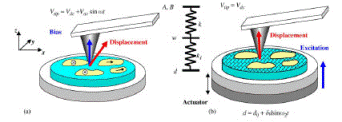Department of Physics and Astronomy: Publications and Other Research

Alexei Gruverman Publications
Document Type
Article
Date of this Version
6-29-2022
Citation
arXiv:2206.14585 [cond-mat.mtrl-sci] 29 June 2022
Abstract
Recently, electrically conducting heterointerfaces between dissimilar band-insulators (such as lanthanum aluminate and strontium titanate) have attracted considerable research interest. Charge transport has been thoroughly explored and fundamental aspects of conduction firmly established. Perhaps surprisingly, similar insights into conceptually much simpler conducting homointerfaces, such as the domain walls that separate regions of different orientations of electrical polarisation within the same ferroelectric band-insulator, are not nearly so well-developed. Addressing this disparity, we herein report magnetoresistance in approximately conical 180° charged domain walls, which occur in partially switched ferroelectric thin film single crystal lithium niobate. This system is ideal for such measurements: firstly, the conductivity difference between domains and domain walls is extremely and unusually large (a factor of at least 1013) and hence currents driven through the thin film, between planar top and bottom electrodes, are overwhelmingly channelled along the walls; secondly, when electrical contact is made to the top and bottom of the domain walls and a magnetic field is applied along their cone axes (perpendicular to the thin film surface), then the test geometry mirrors that of a Corbino disc, which is a textbook arrangement for geometric magnetoresistance measurement. Our data imply carriers at the domain walls with extremely high room temperature Hall mobilities of up to ~ 3,700cm2V-1s-1. This is an unparalleled value for oxide interfaces (and for bulk oxides too) and is most comparable to mobilities in other systems typically seen at cryogenic, rather than at room, temperature.
Included in
Atomic, Molecular and Optical Physics Commons, Condensed Matter Physics Commons, Engineering Physics Commons, Other Physics Commons


Comments
CC-BY